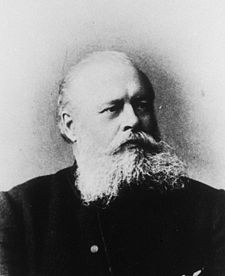- Vladimir Markovnikov
-
Vladimir Vasilyevich Markovnikov 
Late 19th-century photograph of Marknovnikov.Born December 22, 1837
Shusha, RussiaDied February 11, 1904 (aged 66)
Saint Petersburg, RussiaInstitutions University of Kazan
University of Saint Petersburg
University of OdessaAlma mater University of Kazan Doctoral advisor Aleksandr Butlerov Vladimir Vasilyevich Markovnikov (Russian: Марковников, Владимир Васильевич), also spelled as Markownikoff (December 22, 1838 in Nizhny Novgorod - February 11, 1904) was a Russian chemist.
Contents
Life
Markovnikov first studied economics and became, after graduation, assistant of Aleksandr Butlerov in Kazan and Saint Petersburg. After graduation in 1860 he went to Germany for two years where he studied under Richard Erlenmeyer and Hermann Kolbe. He returned to Russia, received his Ph.D in 1869 and succeeded to Butlerov's professorship at Kazan University. After a conflict with that university he was appointed professor at the University of Odessa in 1871, and only two years later at the University of Moscow where he stayed the rest of his career.
Work
Markovnikov is best known for Markovnikov's rule, which he developed in 1869 to describe addition reactions of H-X to alkenes. According to this rule, the nucleophilic X- adds to the carbon atom with fewer hydrogen atoms, while the proton adds to the carbon atom with more hydrogen atoms bonded to it. Thus, hydrogen chloride (HCl) adds to propene, CH3-CH=CH2 to produce 2-chloropropane CH3CHClCH3 rather than the isomeric 1-chloropropane CH3CH2CH2Cl.[1] The rule is useful in predicting the molecular structures of products of addition reactions. Why hydrogen bromide exhibited both Markovnikov as well as reversed-order, or anti-Markovnikov, addition, however, was not understood until Morris S. Kharasch offered an explanation in 1933.
Hughes has discussed the reasons for Markovnikov's lack of recognition during his lifetime. [2] Although he published mostly in Russian which was not understood by most Western European chemists, the 1870 article in which he first stated his rule was written in German. However the rule was included in a 4-page addendum to a 26-page article on isomeric butyric acids, and based on very slight experimental evidence even by the standards of the time. Hughes concludes that the rule was an inspired guess, unjustified by the evidence of the time, but which turned out later to be correct (in most cases).
Markovnikov also contributed to organic chemistry by finding carbon rings with more than six carbon atoms, a ring with four carbon atoms in 1879, and a ring with seven in 1889.
Markovnikov also showed that butyric and isobutyric acids have the same chemical formula (C4H8O2) but different structures; i.e., they are isomers.
References
- ^ W. Markownikoff (1870). "Ueber die Abhängigkeit der verschiedenen Vertretbarkeit des Radicalwasserstoffs in den isomeren Buttersäuren". Annalen der Pharmacie 153 (1): 228–259. doi:10.1002/jlac.18701530204.
- ^ Hughes, Peter (2006). "Was Markovnikov's Rule an Inspired Guess?". The Journal of Chemical Education 83 (8): 1152–1154. doi:10.1021/ed083p1152.
External links
Categories:- 1838 births
- 1904 deaths
- Russian chemists
- Organic chemists
- Russian inventors
Wikimedia Foundation. 2010.
